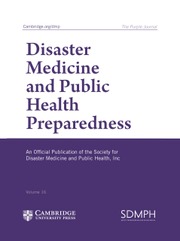Crossref Citations
This article has been cited by the following publications. This list is generated based on data provided by
Crossref.
Lowe, Sarah R.
Bonumwezi, Jessica L.
Valdespino-Hayden, Zerbrina
and
Galea, Sandro
2019.
Posttraumatic Stress and Depression in the Aftermath of Environmental Disasters: A Review of Quantitative Studies Published in 2018.
Current Environmental Health Reports,
Vol. 6,
Issue. 4,
p.
344.
Kar, Nilamadhab
2019.
Depression in Youth Exposed to Disasters, Terrorism and Political Violence.
Current Psychiatry Reports,
Vol. 21,
Issue. 8,
Anika, Nova
Yusuf, Ah
and
Tristiana, Rr Dian
2019.
PENGALAMAN ADAPTASI REMAJA PASCA BENCANA GEMPA DI LOMBOK NUSA TENGGARA BARAT.
Psychiatry Nursing Journal (Jurnal Keperawatan Jiwa),
Vol. 1,
Issue. 2,
p.
36.
Lee, Ju-Yeon
Kim, Sung-Wan
and
Kim, Jae-Min
2020.
The Impact of Community Disaster Trauma: A Focus on Emerging Research of PTSD and Other Mental Health Outcomes.
Chonnam Medical Journal,
Vol. 56,
Issue. 2,
p.
99.
Laksmita, Okki D.
Chung, Min‐Huey
Liao, Yuan‐Mei
Haase, Joan E.
and
Chang, Pi‐Chen
2020.
Predictors of resilience among adolescent disaster survivors: A path analysis.
Journal of Advanced Nursing,
Vol. 76,
Issue. 8,
p.
2060.
Forresi, B.
Soncini, F.
Bottosso, E.
Di Pietro, E.
Scarpini, G.
Scaini, S.
Aggazzotti, G.
Caffo, E.
and
Righi, E.
2020.
Post-traumatic stress disorder, emotional and behavioral difficulties in children and adolescents 2 years after the 2012 earthquake in Italy: an epidemiological cross-sectional study.
European Child & Adolescent Psychiatry,
Vol. 29,
Issue. 2,
p.
227.
Khan, Adrian A.
2021.
Connecting Crises: Young People in Nepal Reflecting on Life Course Transitions and Trajectories during Times of Uncertainty.
Social Sciences,
Vol. 10,
Issue. 11,
p.
439.
Sapkota, Jeet Bahadur
and
Neupane, Pramila
2021.
The Academic Impacts of 2015 Nepal Earthquake: Evidence from Two Secondary Schools in Sindhupalchok District.
Education Sciences,
Vol. 11,
Issue. 8,
p.
371.
Ali, Shaimaa Ahmed Awad
Diab, Samar Salah Eldin Mohamed
and
Elmahallawy, Ehab Kotb
2021.
Exploring the Psychological Stress, Anxiety Factors, and Coping Mechanisms of Critical Care Unit Nurses During the COVID-19 Outbreak in Saudi Arabia.
Frontiers in Public Health,
Vol. 9,
Issue. ,
Adhikari, Surendra Bir
Bhatta, Dharma N.
Rayamajhi, Deelasha
and
Adhikari, Ruchi
2021.
The 2015 Nepal earthquakes and psychosocial impact among Nepali speaking population in the United States of America.
Progress in Disaster Science,
Vol. 9,
Issue. ,
p.
100144.
Sharma, Vinita
Levin, Bruce Lubotsky
Rahill, Guitele J.
Baldwin, Julie A.
Luitel, Aditi
and
Marhefka, Stephanie L.
2021.
Post-earthquake Self-Reported Depressive Symptoms and Post-Traumatic Stress Disorder and their Correlates among College-Youths in Kathmandu, Nepal.
Psychiatric Quarterly,
Vol. 92,
Issue. 4,
p.
1595.
Padrón, Isabel
Fraga, Isabel
Vieitez, Lucía
Montes, Carlos
and
Romero, Estrella
2021.
A Study on the Psychological Wound of COVID-19 in University Students.
Frontiers in Psychology,
Vol. 12,
Issue. ,
Wang, Yue
Ge, Fenfen
Wan, Mentong
and
Zhang, Jun
2021.
Patterns of Depression and Resilience in Children and Adolescents Exposed to an Earthquake: A Latent Profile Analysis.
Psychiatry Investigation,
Vol. 18,
Issue. 6,
p.
580.
Kar, Nilamadhab
and
Sharma, Asmita
2021.
Matching the Symptom Profile of Adolescent Disaster Survivors with Changing Diagnostic Criteria of Posttraumatic Stress Disorder: Focus on ICD-11.
Indian Journal of Psychological Medicine,
Vol. 43,
Issue. 2,
p.
100.
Mzadi, Abdennour El
Zouini, Btissame
Kerekes, Nóra
and
Senhaji, Meftaha
2022.
Mental Health Profiles in a Sample of Moroccan High School Students: Comparison Before and During the COVID-19 Pandemic.
Frontiers in Psychiatry,
Vol. 12,
Issue. ,
Ahmead, Muna
El Sharif, Nuha
and
Asad, Samer
2022.
Healthcare Workers’ Emotions, Perceived Stressors, and Coping Strategies at Workplace during the COVID-19 Pandemic in Palestine.
International Journal of Environmental Research and Public Health,
Vol. 19,
Issue. 19,
p.
11966.
Bailey, Julia
and
Goenjian, Armen
2022.
Lessons Learned in Disaster Mental Health.
p.
137.
KARAKÖSE, Selin
2022.
The Impact of COVID-19 on the People with Mental Illnesses: Health Anxiety, Coping Strategies, and Psychological Well-Being.
AYNA Klinik Psikoloji Dergisi,
Vol. 9,
Issue. 3,
p.
607.
Kar, Nilamadhab
Samantaray, Narendra Nath
Kar, Shreyan
and
Kar, Brajaballav
2022.
Anxiety, Depression, and Post-traumatic Stress a month after 2019 Cyclone Fani in Odisha, India.
Disaster Medicine and Public Health Preparedness,
Vol. 16,
Issue. 2,
p.
670.
Newnham, Elizabeth A.
Gao, Xue
Guragain, Bhushan
Jiao, Feng
Nathan, Elizabeth
Boyes, Mark
and
Leaning, Jennifer
2022.
Daily stressors and mental health following disaster: A school‐based assessment of adolescent disaster survivors in China and Nepal.
Journal of Traumatic Stress,
Vol. 35,
Issue. 6,
p.
1721.


